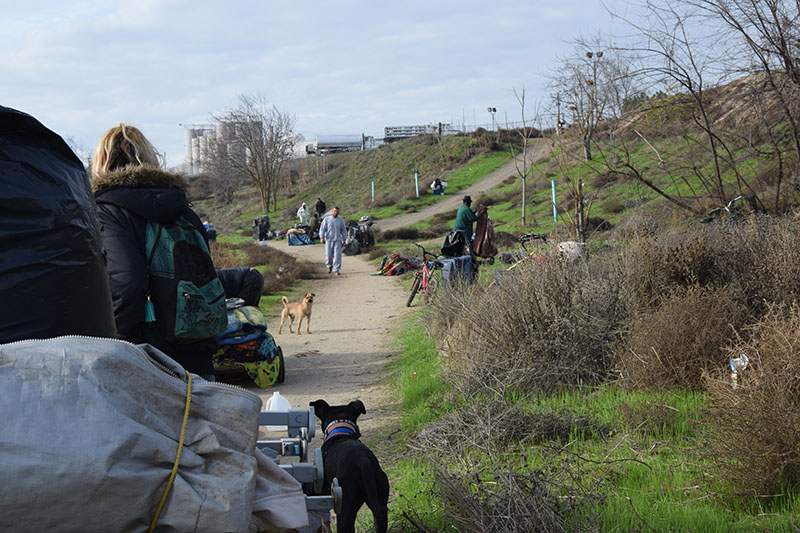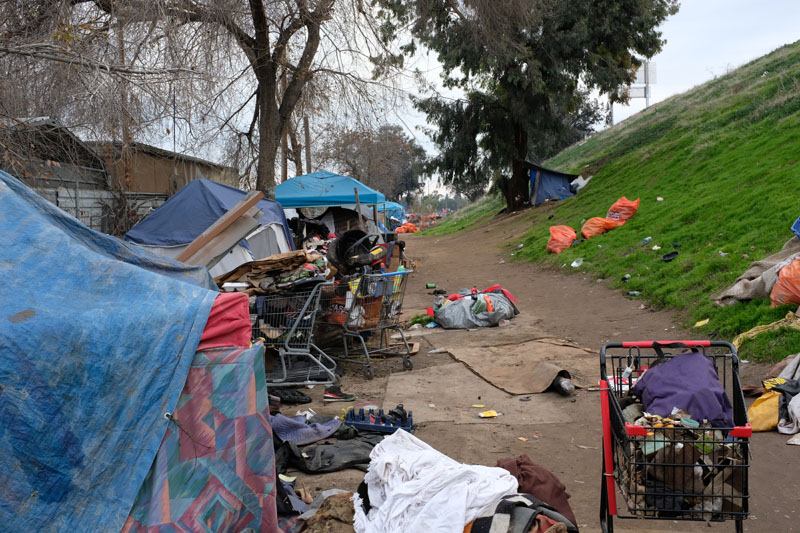
Despite concerted efforts to get people into shelters and affordable housing, homeless numbers in the west have been increasing rapidly.
In Stanislaus County, the numbers haven’t worked since experiments with tent encampments ended a few weeks ago, when the Modesto Outdoor Emergency Shelter (MOES) closed down. City and county authorities decided MOES wasn’t needed after expansion of the city’s Salvation Army Berberian Shelter.
The expansion added 182 beds to the shelter. Residents at MOES numbered some 450 people. Authorities said the shortfall would be in part taken up by opening a repurposed motel on Modesto’s Kansas Avenue early next year. The Kansas Avenue location would take in another 120 people.
When local observers pointed out that even with both new places filled to capacity, over a hundred MOES residents would have no place to go, authorities responded by saying people in the new shelter were expected to find more permanent housing soon and that would open up more places. But more permanent housing is further out of reach than anyone will admit—not just months but years away. And even when MOES was open, hundreds of homeless people remained scattered throughout the region.
In the Bay Area, Google has pledged $1 billion toward providing more housing, but no one thinks even that huge sum will alleviate homelessness any time soon. In Los Angeles, even after a $1.2 billion city bond, few expect to have enough affordable housing to stem the rising tide of homelessness. The most recent count in L.A. County recorded 59,000 homeless people.
Ever since homelessness became an increasingly visible problem, authorities everywhere have promoted the myth of services, assessments, and placement. Few have admitted the glaring truth: No one has enough services for people in need, and there aren’t nearly enough places to put them.
The journey to affordable housing trips on NIMBYism, stumbles over environmental regulations, and falls flat in the face of rising costs. Meanwhile, spiraling housing costs and escalating demands on overburdened social services are pushing more and more people into the streets.

The day MOES closed, trails of people extended in all directions. Some of the displaced residents said they would return to favored locations along the Tuolumne River. One man returned to a local park he used to frequent within an hour of MOES shutting down.
Especially in winter months, most homeless people use tents or tarps for shelter. This year, encampments are everywhere.
Recently, the U.S. Supreme Court refused to hear the 9th Circuit ruling on the rights of homeless people to sleep in public places when there are no other options. Since then, local authorities have been trying to find ways around the ruling.
In Stanislaus County, where a permitted encampment was successful for over a year until shut down, authorities have added “accountability” to the list of tactics sheriffs and police officers will use to address homelessness. To veteran observers, “accountability” looks very much like a return to the catch and release tactics of the past, when rousts and sweeps of homeless people were the routine practice for a problem that won’t go away.

Given affordable housing is at least a few years away, permitted encampments would seem to offer a reasonable alternative to chasing people around and pushing them out of unauthorized camps into our streets and parks. Unfortunately, too many people still believe that services, assessment, and placement are just a few steps away. Instead, we’re approaching ever more dire consequences for people experiencing homelessness, their housed neighbors, and local leaders who still haven’t faced the inconvenient truths about a problem that has escalated beyond their control.
The fact is, whether the problem is in Los Angeles, San Francisco, Seattle or Modesto, too many people have nowhere to go, and too many leaders are operating on default positions of denial and wishful thinking.

The obvious answer is to build camps, on public lands, where homeless people can be sheltered, interviewed and evaluated before treatment and/or re-training to become productive, again.
FDR did this with his Civilian Conservation Corps during the Great Depression. Back then, he allowed only single men, aged 17~28, into these camps; This would be modified now to accommodate almost everyone, preferably at abandoned military installations like the former Castle and George AFB properties.
This does seem like a very viable solution, wonder why after years of an ever increasing homeless population, especially in the West, the Feds haven’t done this?
There obviously is a growing abuse of taxpayer dollars as hundreds of $Millions are spent on this problem annually but, somehow, the numbers of homeless people on our streets continues to grow, seemingly unabated!
A huge bureaucracy is the beneficiary as most of this money goes into rent subsidies [cash disbursements] and ‘administrative costs’. It is apparent that government managed programs are not suited for this problem.
Better that taxpayer money be in grants to NGOs with a proven performance record with the highest percentage of aid actually benefiting the homeless vs an insatiable bureaucracy where the emphasis is always upon the benefit for the bureaucrat.
The 9th Circuit decision, left unchallenged by the SCOTUS, says that folks cannot be criminally charged for camping on public lands if there are no shelters available for them; If there are shelters, we could arrest them and put them into a treatment center with housing.
Let’s open former military properties to NGOs to initiate programs to recondition those properties, utilizing volunteers training the formerly ‘homeless’ in building trades and environmental remediation techniques whereby those still on the streets can be screened and treated appropriately.
Mr. Losh can you cite some sources for your claims?
In dealing with the homeless I have found that these “sub-contractors” that run some of these programs are the biggest abusers of grant monies.
Excellent article, Eric.
I have a brother who is homeless and many people including myself tried helping him out, and in the end the truth came out…he wanted to be free to do as he pleased and not have any responsibilities. He is not a drug addict but he does have mental health problems. I wonder how many people like him are out there. I’m all for helping out people but the truth is a lot of people don’t want help.
Mrs S: There is a condition associated with mental illness called “anosognosia.” It means that mentally ill people don’t believe they’re mentally ill and thus don’t think they need help. This condition is part of the reason so many people believe homeless people don’t want help. In fact their “choices” are driven by their illness.
What needs to.be done is regulations on the rising cost of everything. As every home apartment and essentials rise minimum wage only gets a hike once a year. The living wage outgrew minimum wage years ago and the government are the ones who can put any kind of hault to this problem. The rich are comfortable, middle class died out and poverty is growing everyday. I work 2 jobs and rely on my fasfa college money to barely get by I can end up homeless with one small set back. Nothing the government does helps. They need to make banks fork over empty homes, and businesses for more shelters and hire people to maintain them and hire people to social work the cases so they can offer respite services once housed to prevent reoccurrence. It’s crazy how bad things have gotten makes me think of Roosevelt’s wife trying to help the homeless. How did they overcome.it back then?
It seems like the emphasis is always about a lack of housing. I would be curious to know what percentage of the Homeless are there because of a lack of affordable housing . I would suspect that those who do not want to be on the streets have many safety nets available. We can build all the housing that anyone could ever need and we will still have this problem. Putting homeless inside ,on its own, will not fix this problem. Bad life choices, mental problems,and drug use of a large percentage of the homeless won’t go away, we will just get it off the streets. Homelessness isn’t the problem it is a symptom of a bigger problem.
It’s all that we the homeless have to look foward to get is the help that’s needed with the housing market with no cap continue to rise and the minimum wage is so low in valley that when we do work it’s barely meeting the bills.but those that frame houses and such should developed a relationship with some of the homeless to help teach and build a project together as we will gain experience in the erea that’s needed to help our fellow Americans
Homelessness is a problem. (Duh) and I’m sympathetic, I really am. In the land of plenty, what a shame. But an honest evaluation, due diligence etc etc… The MAJORITY of these people are homeless because THEY made repeated bad choices.. when the rent is due and you choose to party instead.. you end up homeless… I’m not judging, I’ve lost jobs over alcohol; I’ve been shown the exit door for drugs.. it’s a tough row to hoe… And once you’re in the pit, it’s a slippery downward slope… When it’s hot, give em some water; when it’s cold, give em an old pair of socks or gloves. … Maybe a blanket.. give them money and you’ve done them no favors.. they won’t spend it on socks trust me.